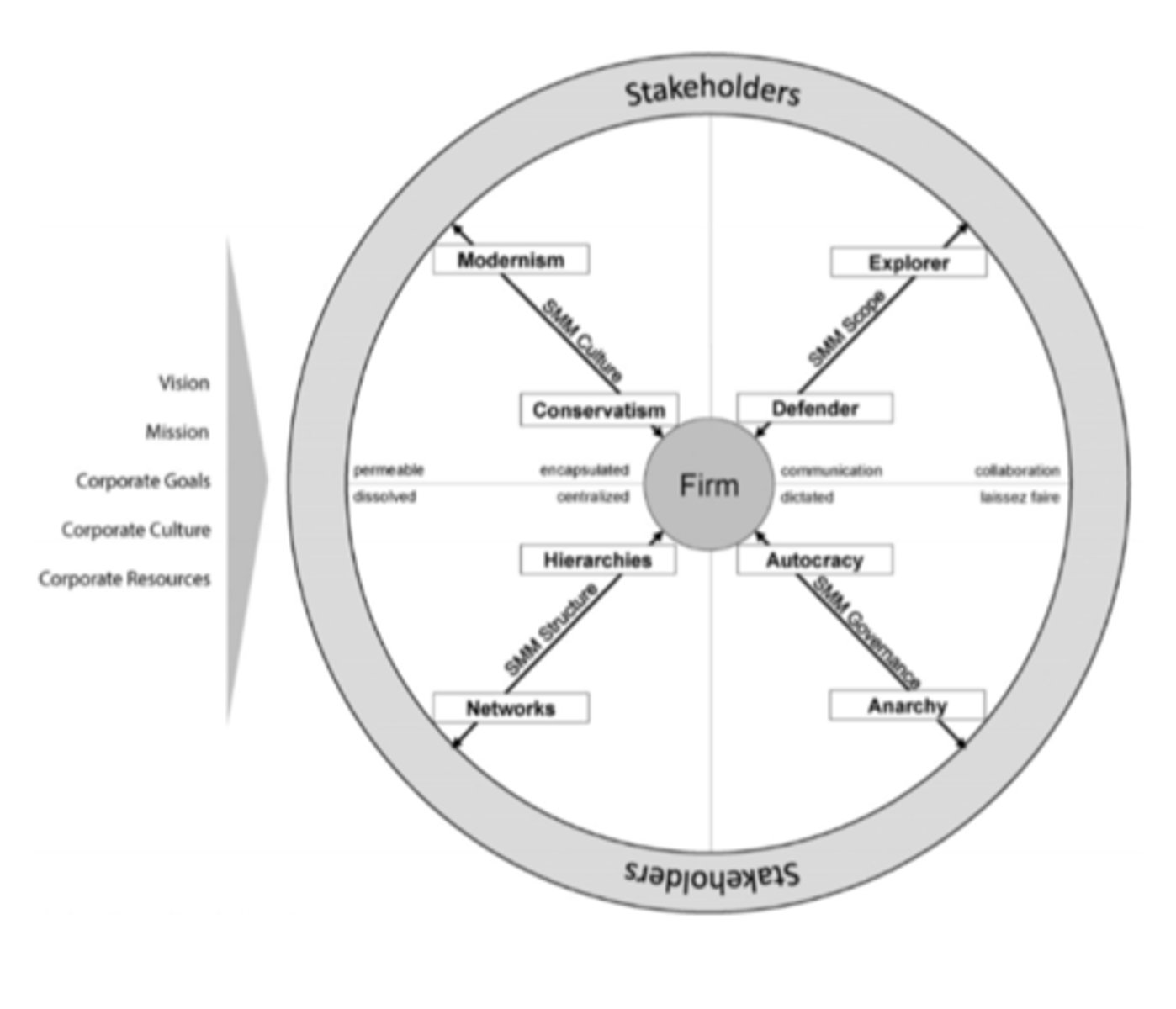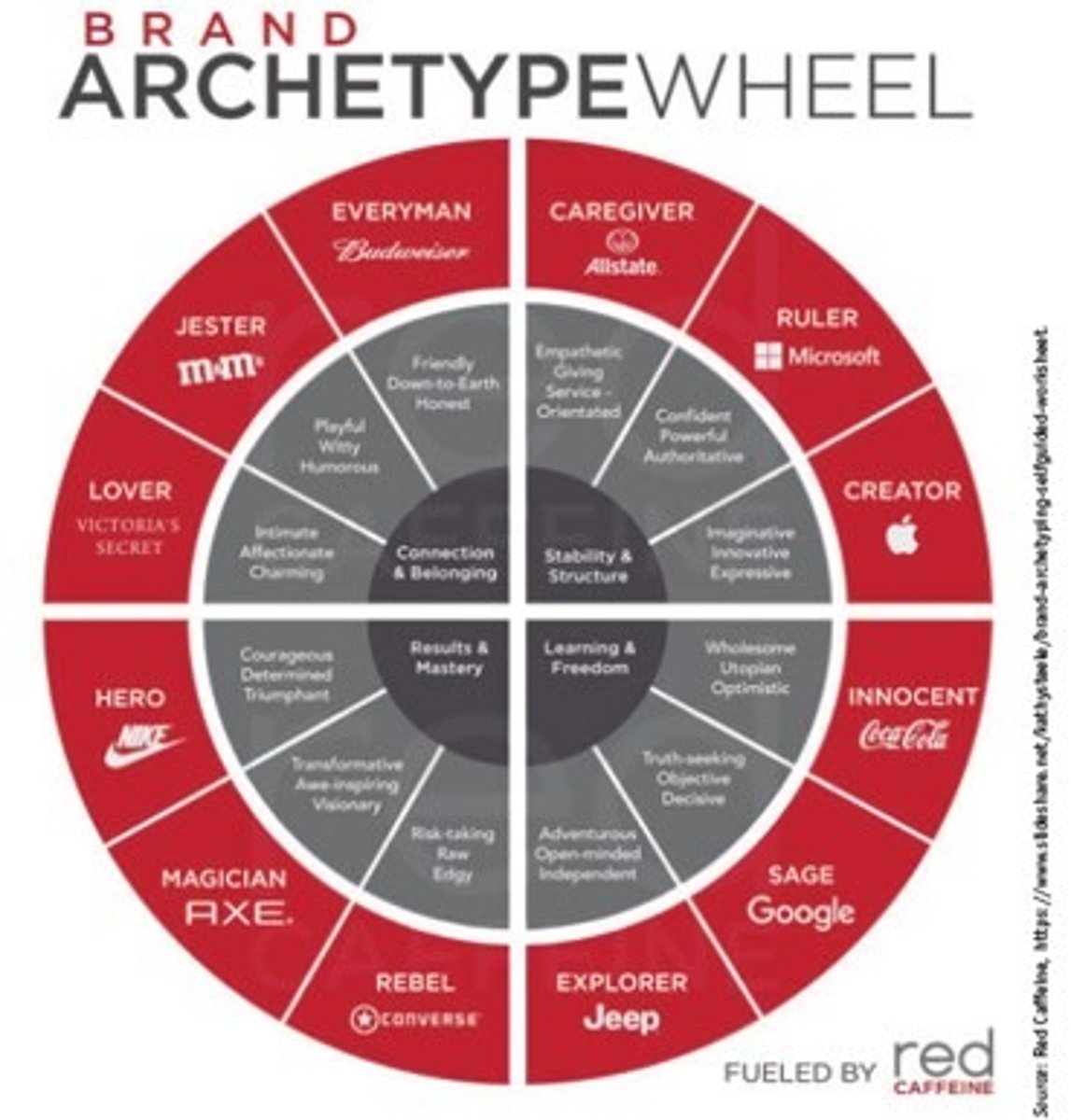SMM Exam 2
1/41
There's no tags or description
Looks like no tags are added yet.
Name | Mastery | Learn | Test | Matching | Spaced |
|---|
No study sessions yet.
42 Terms
Know, identify, and understand each of the 4 dimensions of the holistic framework for SMM
Scope (Defender vs. Explorer) - How SMM is used for communication? *B&B example -Pinterest•
Culture (Conservatism vs. Modernism) - Risk tolerance?Structure (Networks vs. Hierarchies) - How who can access/post to social relates to org structure
Governance (Autocracy vs. Anarchy) -Policies/rules for business use of social, as well as employee use for personal accounts

Know the difference between permission vs. interruption marketing
Interruption: firms purchase the right to interrupt people and demand their attention (TV ads, billboards, magazines)
Permission: relies on attention being earned, organic social media
Understand the differences between traditional marketing ethics and social media marketing ethics
Traditional marketing ethics can be applied to SMM ethics
-SMM principles to apply: Honesty, privacy, respect, responsibility
Know the 3 main components of the customer journey
Awareness, Consideration, Conversion
Know the role of personas relative to social media marketing and the customer journey
Creating buyer personas can assist social media marketers in understanding how potential customers progress through their journey.
Know the 3 components of the Inbound Marketing Methodology and understand how Inbound is used to engage customers in a meaningful and valuable way
Attract, Engage, Delight
Know the goals associated with each component of the Inbound Marketing Methodology (e.g. ATTRACT strangers, ENGAGE prospects and convert them, DELIGHT customers & create brand advocates)
Attract: brands should provide content that prospective customers need and find valuable to target customers in the awareness stage
Engage: focus on developing better relationships with those customers who have shown interest in the brand.
Delight: builds loyalty and can turn the customer into a promoter of the brand.
Know what types of social media content may be presented at each phase of the inbound marketing
Attract: organic posts and paid/sponsored ads
Engage: Retargeting campaigns is one way firms can use social media remind a prospect of the brand, including the specific products they looked at while on the firm's website.
Delight: Using social media as a channel to provide customer service and support is oneway to delight these customers.
Know the best practices for following the rules of engagement for SMM
Rule #1: Use social media channels as intended.
Rule #2: Don't be a dirty spammer.
Rule #3: Have a personality.
Rule #4: Respond to negative posts.
Rule #5: Talk about the topic.
Rule #6: Be strategic with the frequency of posts.
Rule #7: Be careful with using bots.
What does network theory explain?
explains how traditional word-of-mouth (WOM) marketing became eWOM marketing and therefore allowed for information to be transmitted rapidly on the Internet.
Understand how social media marketers choose which social media networks/sites to use
Consider the characteristics of the target audience
Know best practices for optimizing your LinkedIn
Blogs
Create individual news articles
Informative image carousels
Polls
Share PowerPoints, Docs, etc.
Collaborative articles
Facebook for SMM
Males and females
Gen X and Boomers
Contests and giveaways
Promote events
Paid Ads
Promote best blog content -use URL shorteners
Instagram for SMM
75% female, 64% male
Gen Z and Millennials
Be "aesthetic" forward, visually on BRAND
Best for UGC campaigns (HubSpot)
Deliver high-quality content that's visually attractive and valuable (entertaining, educational, fun)
Tik Tok for SMM
More popular with Gen Z
Long format videos
Live
Short format videos
LinkedIn for SMM
56% male and 44% female
Older millennials and Gen X
YouTube for SMM
Gen Z and Male dominant
Pinterest for SMM
Female and millennials dominant
Threads for SMM
68% male and 32% female
Gen Z
What are the most popular social networking sites in the world? In the US?
Facebook, YouTube
Define influencer marketing and explain its purpose
a way brands can promote their products through endorsements or recommendations from influencers and content creators on the Internet.
nano influencers
Achieve/create intimate experiences with audience
1K to 10K followers
Highest engagement rate with their followers (8%)
Most likely to respond to DMs.
micro-influencers
Product reviews, social takeovers, contests, giveaways
10K to 100K followers
Usually specialists in their field
Selective and cautious about developing relationships with brands - prioritize authenticity
Engagement ROI is usually higher than macro- and mega-influencers.
macro influencers
100K to 1M followers
Usually B-list celebrity or expert in field
Understand nature of paid social and how it connects to and supports overall business goals
Businesses paying to display ads or sponsored messages to targeted audiences, or sub segments of their audience.• INTERRUPTION marketing //Disrupting your feed
Know difference between content creators and influencers
Creators CREATE content related totheir interests and/or expertise
Influencers PROMOTE brands via social- to build themselves as a brand
Creators can be influencers, but their major focus is on the content they create - NOT brands they promote
Best practices for paid social strategy
Incorporate paid social and influencer relationships into the overall SMM strategy.
Use research for SMM plans
Know your target market - create personas
Set clear goals for paid strategy - know what you want to accomplish.
Integrate organic and paid social into your SMM strategy.
Monitor brand conversations
Choose influencers carefully
Commit contributing resources to campaign
Monitor both social ROI and Influencer Campaign ROI
Know the roles and functions of organic and paid social within a social media strategy
Organic - permission/inbound marketing; at the mercy of the algorithm and usually limited to existing followers
Paid social - interruption marketing; pay to get your content seen
What does the visual media experience involve? What are its goals?
can include photos or graphics and videos thatcreate an emotional connection and drive the consumer to action.
Study the brand archetype wheel, three "rings" of the diagram, and what each "ring" explains
Outer ring - Brand name and example
Middle ring - Personality traits and characteristics
Inner ring - Primary brand motivations

Know which role customers and brands play in the Hero's Journey
The hero in this story will be the consumer.
The brand archetype will meet the consumer on their journey and be the mentor
A brand should support the consumer in their journey, so identifying the brand archetype as the mentor makes it easier to stay focused on the consumer.
Understand primary, secondary, and tertiary sharing and what each stage entails
First, the primary sharing occurs when the video creator posts it online.
The secondary sharing happens as insiders or friends of the creator share the video.
Tertiary sharing occurs when online viewers begin sharing the video of their own accord.
To be widely disseminated, an online video must pass through all three stages.
Know best practices of video marketing
1. Match the production techniques to the intent of the video.
2. Design and produce videos for mobile-first and always.
3. Design and produce videos for the platforms on which they are to appear.
4. Post videos on multiple platforms and the company website.
5. Optimize videos to be found in search.
6. Encourage viewers to share videos.
7. Finally, a don't! Don't make a sales video.
Know "AEIOU" rule of creating engaging content
Authentic, Entertaining, Intimate, Offbeat, and Unusual.
Know the 4 main content pillars, what each achieves, and examples of each
Educational content is intended to spark curiosity and help readers gain knowledge. Think tips, FAQs, and Top 10 lists.
For entertainment content, try telling an unusual story, or sharing behind-the-scenes perspectives.
Inspiring content should be memorable and positive, with an emotional impact. These could be stories about social responsibility, people-focused stories, or wise words.
Finally, promotional content encourages audiences to take the next step. Tell people what you want them to do with a call to action like, “see link in bio,” “shop now,” or “comment below.
Know and identify the three parts of a content strategy, according to Hootsuite, and the purposes of each of the three components
Research and analysis: Research is the key to understanding what content will resonate with your audience.
Content-specific goals
Plan for sharing content
Benefits of created content vs. curated content
With created content, you can always be sure that it's tonally and visually consistent with your brand voice.
For curated: you don't need a set of creative skills or budget to execute... just an eye for trends and an understanding of how they work with your brand and audience. It can also help you build relationships with other content creators, diversify your content collection quickly, and fill any gaps that might come from having limited resources.
Know what evergreen content is and why it is important
Content that can never be outdated and always reused.
Dates that should be incorporated into your content calendar
dates important to your brand (product launch), dates important to your audience (pride), National and international holidays
How to create a stronger presence on social without financial resources
Make your social profile more attractive to SEO, add relevant keywords to your posts, add relevant hashtags to your posts
Best practices for making image-based content more accessible
-Use descriptive text
Best practices for making video content more accessible
-Subtitles
-Color contrast
-On screen graphic telling audience to turn on audio